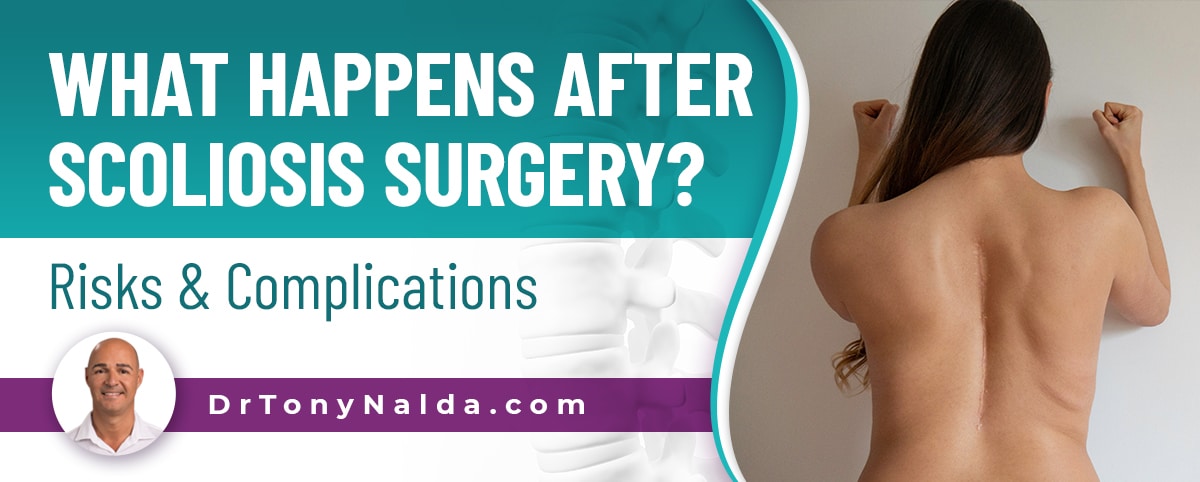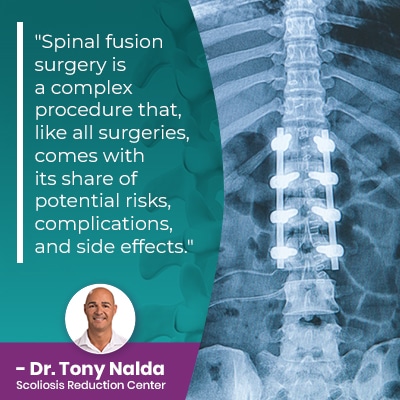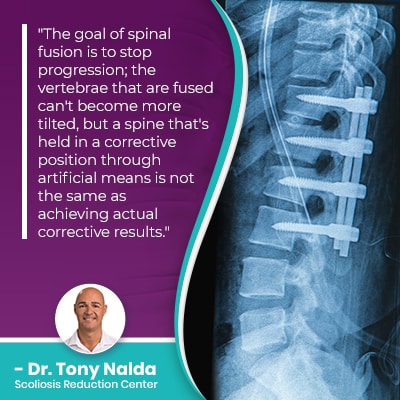What Happens After Scoliosis Surgery? Risks & Complications

There are two main scoliosis treatment approaches for patients to choose between: traditional and conservative. The traditional approach to scoliosis treatment includes watching and waiting and commonly funnels patients towards spinal fusion surgery, while the latter involves non-surgical treatment with proven results.
Many cases of scoliosis don't require surgery, and spinal fusion surgery is a lengthy, costly, and invasive procedure that comes with some serious potential risks; in addition to the potential risks, how the surgery can affect spinal health and function in the long term should also be considered carefully.
Let's first talk about what's happening inside the body of a person recently diagnosed with scoliosis as this gives us a better understanding of general spinal health and function.
Table of Contents
The Scoliotic Spine
A scoliotic spine is one that has an unnatural sideways spinal curve that also rotates, making it a 3-dimensional condition.
A scoliotic spine doesn't have its natural curves and alignment in place, and this disrupts the biomechanics of the entire spine.
The spine has three main sections: cervical (neck), thoracic (middle/upper back), and the lumbar spine (lower back).
Scoliosis can develop in any of the spine's main sections, but is most commonly found in the thoracic spine: the largest of the spinal sections.
Scoliosis is also progressive, and that means that its nature is to get worse over time, and as scoliosis progresses, it gets more complex to treat, which is why being proactive with treatment can be so beneficial.
There are never treatment guarantees, but with scoliosis that's detected and treated early in its progressive line, there are fewer limits to what can be achieved.
Scoliosis also ranges widely in severity from mild to moderate and severe to very severe, and this is determined by a measurement known as Cobb angle:
- Mild scoliosis: Cobb angle measurement of between 10 and 25 degrees
- Moderate scoliosis: Cobb angle measurement of between 25 and 40 degrees
- Severe scoliosis: Cobb angle measurement of 40+ degrees
- Very-severe scoliosis: Cobb angle measurement of 80+ degrees
The higher a patient's Cobb angle, the more severe the condition, and the more noticeable its effects are likely to be.
Now, as a progressive condition, scoliosis is incurable, but it can be highly treatable, but how it's treated can affect the spine's overall health, strength, and function in the future.
Let's move on to addressing the main differences between surgical and non-surgical scoliosis treatment.
Scoliosis Treatment Options: Traditional vs Conservative
 Scoliosis has been around since ancient times, but there is still a lot we don't know about the condition; for example, the condition's most-prevalent form is idiopathic scoliosis, and we still don't fully understand what triggers its initial onset.
Scoliosis has been around since ancient times, but there is still a lot we don't know about the condition; for example, the condition's most-prevalent form is idiopathic scoliosis, and we still don't fully understand what triggers its initial onset.
We do, however, understand what triggers scoliosis to progress, and that is growth and development, which is why patient age is such an important factor when it comes to predicting a patient's likeliest progressive rate.
While traditional scoliosis treatment was the dominant choice for many years, it's neither the best, nor the only treatment option available.
Traditional Scoliosis Treatment
Traditional scoliosis treatment has a reactive response to a scoliosis diagnosis that commonly recommends watching and waiting for signs of further progression, but little is done to proactively work towards preventing progression, and as a progressive condition, scoliosis is virtually guaranteed to get worse at some point.
Traditional scoliosis treatment doesn't have a strategy for addressing mild scoliosis, so is waiting for a patient's scoliosis to progress into the severe classification, which is when patients become surgical candidates.
The truth is, however, that when scoliosis is mild is precisely when it's going to be the most responsive to treatment; the only form of treatment applied prior to a surgical recommendation is traditional bracing, which is associated with a number of shortfalls, so is limited in its potential efficacy.
Spinal fusion surgery is a complex procedure that, like all surgeries, comes with its share of potential risks, complications, and side effects.
Spinal Fusion Surgery
 The process of spinal fusion involves fusing the curve's most-tilted vertebrae into one solid bone, and then rods are often attached to the spine with pedicle screws to hold it in place, and hardware attached is permanent.
The process of spinal fusion involves fusing the curve's most-tilted vertebrae into one solid bone, and then rods are often attached to the spine with pedicle screws to hold it in place, and hardware attached is permanent.
The spine's intervertebral disc that sits between adjacent vertebrae to be fused will also have to be removed, and the discs play many important roles that are key to maintaining spinal health and function.
The goal of spinal fusion is to stop progression; the vertebrae that are fused can't become more tilted, but a spine that's held in a corrective position through artificial means is not the same as achieving actual corrective results.
Risks associated with the surgical procedure itself include excessive blood loss, infection, nerve damage, and adverse reaction to hardware used.
What I really want to highlight, however, are the long-term effects of spinal fusion surgery as these can impact a patient's overall quality of life.
Scoliosis Surgery Recovery Timeline
What happens after scoliosis surgery is known as the recovery process, and the healing process is unique to each patient.
A number of patient/condition variables factor into how a patient responds to spinal fusion, and how quickly they recover from it: patient age and overall health, condition severity, the number of vertebrae fused, location of the fused section, whether or not there were any complications during the procedure, etc.
The days immediately following the procedure are spent in hospital while being closely monitored for signs of infection and taking pain medication; the goal is to be weaned off the pain medications as quickly as possible.
Barring any complications, most patients are released from the hospital within a week to continue their recovery with at home care, during which time activity restrictions are in place so as not to strain the spine while it heals, and this commonly includes lifting, bending, and driving restrictions.
Most patients are completely off pain meds within six weeks following the surgery, with some patients needing them for longer, or shorter periods of time.
Many patients receive their first follow up appointment two weeks after surgery, at which time activity restrictions are modified and pain medication is adjusted accordingly, and many are cleared for normal activities within 4 to 6 weeks following the procedure.
Long-Term Effects of Spinal Fusion Surgery
It's important for patients to understand, however, that even after surgical recovery, a fused spine is always going to be more vulnerable to injury, and what many patients are disappointed in is a noticeable loss in spinal flexibility and range of motion; this can mean more activity restrictions and being unable to take part in once-loved activities and sports.
Many patients are also disappointed with increased pain at the fusion site.
Another factor to consider is that the only recourse if a fusion is unsuccessful, or a hardware issue occurs over time, is more surgery, and the risks of spinal surgery only increase with age.
The spine's natural design is based on movement, so a fused spine is contrary to its movement-based design, which is why it can't function as optimally as a scoliotic spine that's treated without surgery.
Conservative Scoliosis Treatment
Here at the Scoliosis Reduction Center, I treat patients with a modern conservative chiropractic-centered treatment approach because I feel this is what is most aligned with the spine's natural movement-based design.
I want to preserve as much of the spine's natural health, strength, and function as possible, and I do this through a less-invasive and more natural form of treatment.
First of all, conservative treatment is more proactive than reactive as it focuses on how best to prevent progression and increasing condition effects.
I start treatment as close to the time of diagnosis as possible because scoliosis only becomes more complex to treat as it progresses, and it's far more effective to proactively work towards preventing increasing condition effects, than it is to work towards reversing them once they've developed.
Scoliosis progressing means the size of the scoliotic curve is increasing, as are the condition's uneven forces, and their effects.
As scoliosis progresses, the spine gets increasingly rigid, making it less responsive to treatment, and certain therapeutic exercises that are part of treatment can be difficult for patients who have experienced significant progression to perform.
Conservative treatment involves integrating multiple condition-specific treatment disciplines so conditions can be impacted on every level.
Chiropractic care works towards impacting the condition on a structural level by reducing the curvature and realigning the spine.
Physical therapy helps increase core strength so the spine's surrounding muscles can provide it with optimal support.
Corrective bracing can be particularly effective on growing spines and helps by pushing the spine into a corrective position, and a series of custom-prescribed home exercises can help patients establish a home-rehabilitation program for further stabilizing the spine for long-term treatment results.
When I have treated scoliosis successfully, this means that, first and foremost, as a structural spinal condition, the spine's structural abnormality (tilted and twisted vertebrae) has been addressed through chiropractic care, core strength has been increased so there is less pressure on the spine and its individual parts, corrective bracing has helped push the spine into a corrective position, and rehabilitation is an ongoing phase of treatment to ensure sustainable long-term treatment results.
Conclusion
So what happens after scoliosis surgery will depend on a number of factors that vary from patient to patient, but the main focus is recovery and healing.
The immediate days following spinal fusion are spent in the hospital where patients can be monitored closely for signs of infection or other complications, with most patients being released to continue the recovery process at home within a week.
The recovery process will involve pain medication and restrictions from strenuous activities and movements such as contact sports and instructions to avoid lifting, bending, and twisting to avoid injury and straining the spine.
During the recovery period, it's very important to follow doctor's orders to ensure the spine is healing as it should, and the goal is to wean patients off their pain medications effectively.
Most patients receive a post-surgical check up within two weeks after surgery, and activity restrictions and pain medications can be modified and adjusted accordingly.
Many patients can return to daily activities within 2 to 4 weeks after surgery, with more strenuous activities taking longer to return to, if at all.
Now, barring any complications, many patients can make a full recovery, but I want patients to also be aware of is that a full recovery from the procedure doesn't mean the spine has fully returned to its post-surgical, and/or post-scoliosis, state.
A spine that's fused is weaker and less functional, meaning it might not be flexible enough to return to many once-loved activities and sports, and this can greatly impact a patient's quality of life, especially when we're talking about active adolescents.
The fact is that when it comes to the long-term effects of spinal fusion as in 20, 30, 40+ years down the road, not enough studies have been done to truly understand the effect of living with a fused spine over time, not to mention the longevity of hardware used.
So what I want for my patients is to be aware of all treatment options available to them, and for those who choose to forgo a surgical recommendation, or prefer to try a less-invasive treatment option first, I've been treating scoliosis patients successfully, without surgery, for over 20 years.
Dr. Tony Nalda
DOCTOR OF CHIROPRACTIC
After receiving an undergraduate degree in psychology and his Doctorate of Chiropractic from Life University, Dr. Nalda settled in Celebration, Florida and proceeded to build one of Central Florida’s most successful chiropractic clinics.
His experience with patients suffering from scoliosis, and the confusion and frustration they faced, led him to seek a specialty in scoliosis care. In 2006 he completed his Intensive Care Certification from CLEAR Institute, a leading scoliosis educational and certification center.
About Dr. Tony Nalda
 Ready to explore scoliosis treatment? Contact Us Now
Ready to explore scoliosis treatment? Contact Us Now





